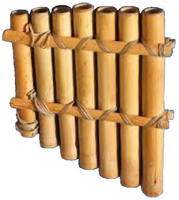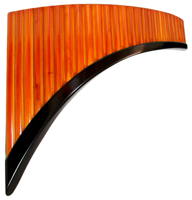
|
The Society of Folk Dance Historians (SFDH)
Romanian Pipes of Pan
[
Home |
About |
Encyclopedia | CLICK AN IMAGE TO ENLARGE |

|
The Pan pipe, known as the "nai" in Romania, has been known through the ages by many names: Pipes of Pan, Pandean pipes, Pan's pipes, Musical, and Sryinx. It belongs to the family of flutes that exist in a great variety in Romania. This family of instruments is dear to the people of Romania and many of their folk legends and beliefs involve one of its members.
 The instrument goes back to the ancient Greeks and it is shown in the art of that time. Pan, in Greek Mythology, was the god of forests, fields and wild animals, although he favored the flocks and herds. He had a man's body with the legs, horns, and ears of a goat. Being identified with flocks, he played a pipe and roamed the hills as would a shepherd.
The instrument goes back to the ancient Greeks and it is shown in the art of that time. Pan, in Greek Mythology, was the god of forests, fields and wild animals, although he favored the flocks and herds. He had a man's body with the legs, horns, and ears of a goat. Being identified with flocks, he played a pipe and roamed the hills as would a shepherd.
 The Pan pipe is made up of a number of reeds, bamboo, or elder tree wood tubes of varying lengths. These tubes are connected lengthwise and are closed at one end. Although three hundred years ago the Pan pipe had only seven or eight pipes, it now has as many as twenty-five. The Pan pipe was nearly lost during the period between World War I and World War II, and only lately has it risen in status in Romanian folk art.
The Pan pipe is made up of a number of reeds, bamboo, or elder tree wood tubes of varying lengths. These tubes are connected lengthwise and are closed at one end. Although three hundred years ago the Pan pipe had only seven or eight pipes, it now has as many as twenty-five. The Pan pipe was nearly lost during the period between World War I and World War II, and only lately has it risen in status in Romanian folk art.
In making the Pipes of Pan, wax is poured into each tube, changing its length until the desired pitch is reached. Wax is also used to seal any small openings between the pipes.
The Pan pipe is played by blowing across the top of the tubes much in the same manner as in playing a flute, or in producing a sound with a bottle. A change in pith can be accomplished by tilting the instrument to different angles. The pitch can also be altered by dropping dried peas or beans into the pipes.
The tone produced on the Pan pipe is both clear and beautiful. There are, however, few musical pieces that can adequately show off what can be done with it. Most commonly, its possibilities are shown by the imitation of various kinds of birds while playing the well known Doina or Ciocârlia.
DOCUMENTS
- Romania, a country.
- Romanian Folk Music Instruments, an article.
From "The Tamburitzan," Vol. 4 - No. 6
Pittsburg, Pennsylvania, March-April, 1962.
This page © 2018 by Ron Houston.
Please do not copy any part of this page without including this copyright notice.
Please do not copy small portions out of context.
Please do not copy large portions without permission from Ron Houston.